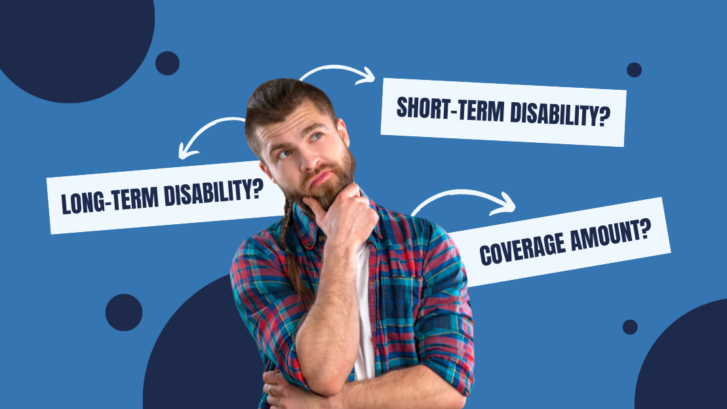Long-Term Disability Insurance: Top Questions
Long-term disability insurance (LTD) is a critical but often misunderstood aspect of financial planning. It provides a safety net in case you become unable to work due to a disability, ensuring that you can continue to meet your financial obligations and maintain your quality of life. In this blog, we will answer some of the top questions people have about long-term disability insurance, shedding light on its importance and how it can benefit you.
What’s the difference between short-term and long-term disability insurance?
Short-term disability insurance typically covers disabilities that last for a few months, providing benefits that kick in quickly to replace a portion of your income.
Long-term disability insurance is designed for more extended periods of disability, covering you for several years or even until retirement if necessary. Long-term disability insurance offers more comprehensive coverage, ensuring you have financial support over the long haul.
What’s the difference between long-term disability and long-term care insurance?
Long-term disability insurance replaces your income if you’re unable to work due to a disability.
Long-term care includes services that meet the medical and non-medical needs of people with disabilities, chronic illnesses, or cognitive disorders who can’t care for themselves. Long-term care insurance covers the cost associated with this type of care for an extended period of time, at home or in a long-term care facility.
Both types of insurance serve different purposes and should be considered separately in your financial plan.
Won’t social security and workers’ compensation cover my needs?
Social Security disability benefits and workers’ compensation can provide some financial support in the event of a disability, but they have limitations. Social Security disability benefits often have strict eligibility criteria and may not replace your full income. Workers’ compensation only covers disabilities resulting from work-related injuries or illnesses. Long-term disability insurance offers broader coverage by providing a benefit when you are unable to work due to a covered disability, regardless if the disability is work-related or not.
How much coverage will I need?
Factors to consider include your monthly expenses, existing savings, and any other sources of income. Calculating the appropriate coverage amount ensures you’ll have the financial support you need without overextending your budget.
Here are a few things to keep in mind when calculating coverage:
- Assess Your Existing Financial Resources: Start with your income, and take into account any existing disability benefits you may have, such as employer-sponsored disability insurance, Social Security Disability Insurance (SSDI), or personal savings. These resources will reduce the amount of coverage you need.
- Determine Your Monthly Expenses: Start by listing all your monthly expenses, including rent or mortgage, utilities, groceries, transportation, insurance premiums, and discretionary spending. Be as comprehensive as possible.
- Consider the Benefit Period: Decide how long you want your disability insurance to provide benefits. Common benefit periods are 2 years, 5 years, or until age 65. Longer benefit periods typically require higher premiums.
- Determine the Benefit Amount: Disability insurance typically replaces a percentage of your pre-disability income. This percentage can vary, but it’s often around 60-80% of your pre-disability earnings. Use this percentage to calculate the benefit amount.
Don’t forget to account for taxes. Remember that disability insurance benefits may be taxable depending on whether you pay the premiums with pre-tax or post-tax dollars. Adjust your calculations accordingly and be sure to consider how inflation can affect your expenses over time.
Everyone’s financial situation and insurance needs are unique, so it’s important to personalize your calculations based on your individual circumstances and preferences. You should also be aware of policy exclusions, as certain conditions may not be covered, and consider how these exclusions could affect your overall coverage. A professional insurance agent or broker can also help you navigate these exclusions.
Why do young people need long-term disability insurance?
Many young individuals underestimate the importance of long-term disability insurance. However, disabilities can strike at any age, and statistics show that disability incidence among younger demographics is more common than you might think. One in four of today’s 20-year-olds will become disabled before retirement age.
Enrolling in disability insurance early not only protects your future income but also typically results in lower premiums. Investing in your financial security while you’re young can provide peace of mind for years to come.
How does the application process work?
The application process for long-term disability insurance involves several steps. Once you’ve researched and chosen a policy, you or your insurance agent or broker will complete an application. Here is some information that may be required:
- Personal information such as name, date of birth, contact details.
- Employment information, including current occupation and employer.
- Income details, including gross annual income and any other income sources.
- Medical history, like current health status, present and past medical conditions, medications, surgical history, etc.
- Information about lifestyle, such as smoking and alcohol consumption.
- Financial information, like mortgage, rent and other debts.
- Additional documentation may be required.
It’s essential to be thorough and accurate in your application to avoid potential delays in the process. Once your application is submitted, the process can take two to six weeks, depending on the benefit amount selected and the complexity of your personal situation. Sometimes, the carrier may require you to get a medical examination or provide additional healthcare records so medical underwriting can be completed.
Once any documentation or requirements are met, the next step is review and approval or denial of your application, followed by a policy issuance if approved.
Conclusion
Long-term disability insurance is a critical component of financial planning, providing essential protection in the event of a disability. By obtaining LTD coverage, you can ensure that you’re prepared for the unexpected and can maintain financial stability in challenging times.
Visit the long-term disability insurance page to view instant quotes and apply online.









